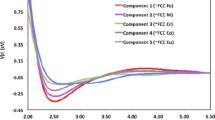Abstract
The success of perturbation calculations of second order for the NFE (“Nearly Free Electron”) metals and that of the two-parameter model of Pettifor for the transition elements show that the lattice-stability of the metals has simple physical reasons. Using the results of Harrison, Heine and Weaire, Deegan, and Pettifor, a model is developed which allows to explain the stability of the three metal lattices in terms of differences in the potentials. Only those potential differences are considered which are caused by the different packing of the lattices. With the aid of the virial theorem the band structure energy is connected with the potential bandstructure energy. The sequence of stability is predicted to be body centered cubic (bcc), hexagonal close packed (hcp), face centered cubic (fcc) with increasing valence electron concentration. The ranges of stability can be expressed in simple numbers. This simple model holds in principle for NFE as well as for transition metals because it contains no assumptions restricted to only one of these metal types. Deviations of the observed lattice stability from the model can be understood from the approximations involved.
Similar content being viewed by others
References
Krebs, H.: Grundzüge der anorganischen Kristallchemie. Stuttgart: Ferdinand Enke Verlag 1968
Altmann,S.L., Coulson,C.A., Hume-Rothery,W.: Proc. Roy. Soc. A240, 145 (1957)
Asdente,M., Friedel,J.: Phys. Rev.124, 384 (1961)
Brauer,W.: Einführung in die Elektronentheorie der Metalle. Leipzig: Akademische Verlagsgesellschaft 1972
Harrison,W.A.: Pseudopotentials in the theory of metals. New York: W.A. Benjamin 1966
Heine,V., Weaire,D.: Pseudopotentialtheory of cohesion and structure. Solid State Physics, Vol. 24 1970
Blandin,A., in: Phase stability in metals and alloys, Rudman,P.S.et al. Eds. New York: McGraw Hill 1966
Hubbard,J.: Proc. Phys. Soc.92, 921 (1967)
Hubbard,J., Dalton,N.W.: J. Phys. C (Proc. Phys. Soc.) Ser.2, 1637 (1968)
Pettifor,D.G.: J. Phys. C (Proc. Phys. Soc.), Ser.2, 1051 (1969)
Pettifor,D.G.: Metallurgical chemistry, O. Kubaschewski. National Physical Laboratory 1972
Kohn,W., Rostoker,N.: Phys. Rev.94, 1111 (1934)
Deegan,R.A.: J. Phys. C (Proc. Phys. Soc.)2, 763 (1968)
Averill,F.W.: Phys. Rev. B6, 3637 (1972)
Brewer,L.: Science 161, 3837, 115 (1968)
Landolt-Börnstein: Band IV, Zahlenwerte und Funktionen. Springer Verlag 1964
Rechenduden IV. Mannheim: Bibliographisches Institut, Dudenverlag 1964
Ziman,J.M.: Principles of the theory of solids. Cambridge: University Press 1965
Heine,V.: Phys. Rev.153, 673 (1967)
Slater,J.C.: Quantum theory of molecules and solids, Vols. 1, 2, 3. New York: McGraw-Hill 1966
Lafon,E.E., Lin,C.C.: Phys. Rev.152, 579 (1966)
Chaney,R.C., Tung,T.K., Lin,C.C., Lafon,E.E.: J. Chem. Phys.52, 361 (1970)
Author information
Authors and Affiliations
Additional information
Part of the dissertation, Stuttgart 1973. Dedicated to Professor Dr. Heinz Krebs, who deceased on May 21, 1974, in Stuttgart.
Rights and permissions
About this article
Cite this article
Reiser, B. On the lattice stability of metals. Theoret. Chim. Acta 41, 287–299 (1976). https://doi.org/10.1007/BF01177997
Received:
Issue Date:
DOI: https://doi.org/10.1007/BF01177997




